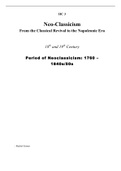HC 3
Neo-Classicism
From the Classical Revival to the Napoleonic Era
18th and 19th Century
Period of Neoclassicism: 1760 –
1840s/50s
- Rachel Essner
, Introduction
Good books about 17th - 20th century art:
T.J. Clark: “Art grows from 2 places”:
- From history
- From society → Role that art plays in society; the way it
reflects society or grows out of society. Social, political and
historical circumstances in which art flourishes
Art is not (just) a product of other art, of an aesthetic point of view
or of artistic expression. Art and artists are a part of what’s going
on in a certain time – a part of history and society.
Content:
1. Introduction: The Enlightenment and the Classical Revival
2. Neo-Classicism in Art
3. Neo-Classicism during French Revolution, and in Jacques-Louis David’s art
4. (The beginning of the end of the typical) Neo-Classicism, during the Napoleonic Era
I will talk about:
Where did neo-classicism come from?
What were the ideological and artistic fundamentals that led to neoclassicism?
Under what kind of social and intellectual circumstances did it arrize?
What art did it produce?”
I will focus on French painting, because:
- The way in which the French art world was organized
- The French produced the most conservative and most avant-garde art
, 3.1. The Enlightenment, the Classical Revival & Neo-Classicism in Art
‘The Enlightenment’: (17th and 18th Century – 1815 (Napoleon))
The enlightenment was a philosophical movement, which was about social, scientific, economic
and political revolutions. It was a whole new way of thinking about how society should be
organized, role of governments, individual citizens, etc. Neoclassicism was a product of this
enlightenment.
A phrase summarizing the idea(l)s of the enlightenment = Liberte, egalite, fraternit = ideals
which also became the slogan of the French Revolution was based.
Thinkers of the Enlightenment, luved classics
Most important thinkers of the enlightenment thought about the best model of government, and
about how to approve social and political conditions:
- Voltaire They thought the ancient republics of Greece and Rome were the models of
- Rousseau how society should be organized, these being the correct (rational, logical)
- Diderot ways of living and thinking.
WHY Neo-classicists HATED Rococo
EXAMPLE Jean-Honoré Fragonard: The Swing
Subject: flirting, immoral, sexual - clandestine
Style: Fluffy, sensual, sweet soft way of painting
Setting: contemporary garden
Thinkers about art in 19th c. said artists should look back at (and imitate) the art of antiquity, in
order to create works that were going to be instilling these ideas of republicanism and rational,
proper, civic, moral ways of thinking. → Art should appeal to the mind, not to the senses.
Just like in politics, artists should look back at antiquity, art of the renaissance and of the
classical revival of the 18th century, like:




